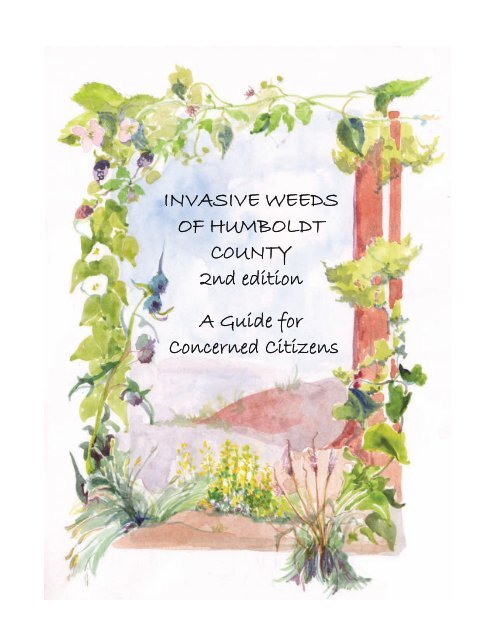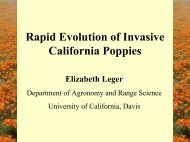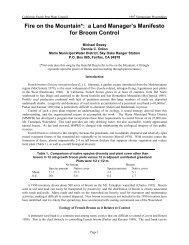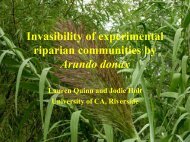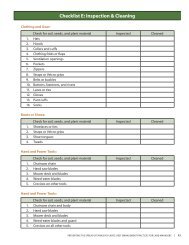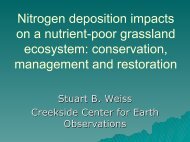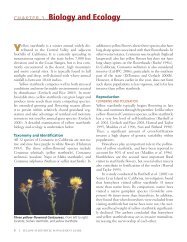Invasive Weeds of Humboldt County - Northcoast Chapter of CNPS
Invasive Weeds of Humboldt County - Northcoast Chapter of CNPS
Invasive Weeds of Humboldt County - Northcoast Chapter of CNPS
Create successful ePaper yourself
Turn your PDF publications into a flip-book with our unique Google optimized e-Paper software.
INVASIVE WEEDS<br />
OF HUMBOLDT<br />
C0UNTY<br />
2nd edition<br />
A Guide for<br />
Concerned Citizens
Inset: © 2008 Neal Kramer<br />
Walter Knight © California Adademy <strong>of</strong> Sciences<br />
© 2008 Neal Kramer<br />
© 2003 Christopher L. Christie<br />
European Beachgrass, pg 4<br />
Iceplant, pg. 4<br />
Yellow Bush Lupine, pg. 4<br />
Fennel, pg. 5<br />
© 2001 CDFA<br />
© 2005 BonTerra Consulting; © 2009 Zoya Akulova<br />
© 2006 David A. Tharp<br />
© 2005 George Rembert<br />
Foxglove, pg. 5<br />
Gorse, pg. 5<br />
Himalayan Blackberry, pg. 5<br />
Jubata Grass, pg. 6<br />
© 2008 Gary McDonald<br />
© 2005 Louis M. Landry; Inset: 2009 Zoya Akulova<br />
Gerald & Buff Corsi © California Academy <strong>of</strong> Sciences<br />
© 2005 Louis M. Landry<br />
Klamathweed, pg. 6<br />
Poison Hemlock, pg. 6<br />
Scotch Broom, pg. 7<br />
French Broom, pg. 7<br />
© 2001 CDFA<br />
© 2005 Christopher L. Christie<br />
© 2008 Kier Morse<br />
© 2001 CDFA<br />
Spanish Heath, pg. 7<br />
Teasel, pg. 7<br />
Bull Thistle, pg. 8<br />
Canada Thistle, pg. 8<br />
More photos on inside <strong>of</strong> back cover
CONTENTS<br />
Introduction<br />
How to use this guide .............................................................................................. 2<br />
What is an invasive weed ...................................................................................... 2<br />
Why worry about invasive weeds........................................................................... 2<br />
What can you do .................................................................................................... 3<br />
Plants that Invade Coastal Sand Dunes<br />
European Beachgrass ............................................................................................ 4<br />
Iceplant ................................................................................................................... 4<br />
Yellow Bush Lupine ................................................................................................ 4<br />
Plants that Invade Grasslands, Fields, and Roadsides<br />
Fennel ..................................................................................................................... 5<br />
Foxglove ................................................................................................................. 5<br />
Gorse ...................................................................................................................... 5<br />
Himalayan Blackberry ............................................................................................. 5<br />
Jubata Grass and Pampas Grass ........................................................................... 6<br />
Klamathweed .......................................................................................................... 6<br />
Poison Hemlock ...................................................................................................... 6<br />
Scotch Broom and French Broom ........................................................................... 7<br />
Spanish Heath ........................................................................................................ 7<br />
Teasel ..................................................................................................................... 7<br />
Thistles<br />
Bull Thistle and Canada Thistle ......................................................................... 8<br />
Spotted Knapweed, Diffuse Knapweed, and Meadow Knapweed ..................... 8<br />
Yellow Star Thistle ............................................................................................. 8<br />
Plants that Invade Forest Habitats<br />
Butterfly Bush ......................................................................................................... 9<br />
Cotoneaster (Orange and Silverleaf) ....................................................................... 9<br />
English Holly ........................................................................................................... 9<br />
Ivies<br />
English Ivy ....................................................................................................... 10<br />
Cape (German) Ivy .......................................................................................... 10<br />
Pittosporum (Victorian Box) ................................................................................... 10<br />
Plants that Invade Streambanks<br />
Japanese Knotweed, Himalayan Knotweed, and Giant Knotweed ....................... 11<br />
Periwinkle ............................................................................................................. 11<br />
Tree <strong>of</strong> Heaven ..................................................................................................... 11<br />
Plants that Invade Wetland Habitats<br />
Parrotfeather .......................................................................................................... 12<br />
Purple Loosestrife ................................................................................................. 12<br />
Spartina ................................................................................................................ 12
Introduction<br />
How to use this guide<br />
This guide is intended to help you understand the problem <strong>of</strong> invasive weeds, identify them around<br />
your home and community, and take direct action to save our wildlands and protect our natural and<br />
agricultural resources from the threat <strong>of</strong> invasion.<br />
We grouped the weeds by the primary habitat type that they invade. This does not mean, however,<br />
that you won’t find them in other habitats as well. While some species are fairly specific—for example,<br />
European beachgrass is restricted to coastal sand dunes—other weedy species such as pampas<br />
grass can occur in a variety <strong>of</strong> habitats, from dunes to roadsides to your neighbor’s backyard.<br />
Color photos are provided on the inside front and back covers <strong>of</strong> this guide, arranged in the same order<br />
as they appear in the text. In addition to the weeds presented here, numerous other invasive<br />
weeds occur in <strong>Humboldt</strong> <strong>County</strong>. To learn more about them, visit our website at http://<br />
www.cdfa.ca.gov/go/<strong>Humboldt</strong>WMA or consult the other web resources and books listed on the back.<br />
Report new sightings <strong>of</strong> red alert weed species. While most weeds listed here are widespread<br />
in <strong>Humboldt</strong> <strong>County</strong>, some are relative newcomers or have a limited distribution. Finding new infestations<br />
<strong>of</strong> “red alert” species and responding quickly is the most cost-effective means <strong>of</strong> control.<br />
Look for the phone symbol throughout this guide to indicate which species to report. If you find them,<br />
call Bruce Bryan, <strong>Humboldt</strong> <strong>County</strong> Department <strong>of</strong> Agriculture, 441-5271, bbryan@co.humboldt.ca.us.<br />
What is an invasive weed<br />
Most people are familiar with the concept <strong>of</strong> weeds in the context <strong>of</strong> their yard or garden. <strong>Weeds</strong> are<br />
simply undesirable plant species. This same principle holds true for our natural areas, which are home<br />
to a diverse array <strong>of</strong> native plants. The number and variety <strong>of</strong> these native species is described by the<br />
term “biological diversity.” Over the past 150 years, many non-native plants have been introduced to<br />
our region, both accidentally and intentionally. Many do not pose an ecological threat, however, some<br />
are able to reproduce in the wild and proliferate rapidly and cause the decline or loss <strong>of</strong> our native<br />
plants. Others invade agricultural lands, becoming pests that compete with crops, reduce forage values,<br />
and may be poisonous to livestock. We call these invasive weeds.<br />
Why worry about invasive weeds<br />
<strong>Invasive</strong> weeds:<br />
Change the look and function <strong>of</strong> landscapes and ecosystems. <strong>Invasive</strong> weeds are smothering<br />
diverse forest, wetland, dune, and grassland flora, cutting <strong>of</strong>f the base <strong>of</strong> diverse food webs.<br />
Cost us money. $82 million dollars is spent annually in California to fight invasive weeds, and the<br />
cost <strong>of</strong> impacts is estimated at over $2.4 billion (Cal-IPC 2009). <strong>Invasive</strong> plants harm local agricultural<br />
economies by out-competing native forages and interfering with forest regeneration.<br />
Increase the risk <strong>of</strong> fire. Prolific growth <strong>of</strong> some weeds, especially flammable woody plants and<br />
annual grasses, increase the risk <strong>of</strong> wildland fires and/or fires in urban areas.<br />
Reduce recreational opportunities. <strong>Invasive</strong> weeds can form impenetrable thickets that make<br />
access to recreational areas difficult or directly degrade the aesthetic value <strong>of</strong> parklands.<br />
Alter hydrology and/or impede water flows. Aquatic invasive weeds can clog waterways, affect<br />
water quality, an/or interfere with complex aquatic food webs that affect numerous organisms.<br />
Change native soils chemically and physically. Some invasive weeds release chemicals into<br />
the soil that make it hard for other plants to grow. <strong>Weeds</strong> can also physically alter soil structure.<br />
Disrupt wildlife corridors and bird migratory routes. <strong>Weeds</strong> can restrict movements by wildlife.<br />
Contribute to the decline <strong>of</strong> native species. <strong>Invasive</strong> weeds are a major driver <strong>of</strong> plant and animal<br />
species decline, primarily due to habitat loss from ecosystem conversion. In some cases, the<br />
damages are irreversible, possibly leading to species extinction.<br />
2
Introduction<br />
What can you do<br />
Your individual actions to combat the threat <strong>of</strong> invasive weeds will make a difference! Your efforts will<br />
help protect the diversity <strong>of</strong> native plant communities in <strong>Humboldt</strong> <strong>County</strong>.<br />
Don’t plant invasive species.<br />
Be selective when you choose plants for home landscaping. Some invasive plants are still sold in<br />
nurseries and garden shops, so beware! If you plant these in your yard, they may escape into nearby<br />
natural areas. There are many beautiful horticultural plants available for you to choose from that are<br />
not invasive. Consider planting native plant species in your home garden. Natives <strong>of</strong>fer a good choice<br />
for home landscaping because they are well-adapted to local conditions and <strong>of</strong>ten thrive with less care<br />
and less water than required by many non-natives. Native plant gardening enhances the value <strong>of</strong> your<br />
yard for local wildlife including birds and butterflies. Check web resources on the back for suggestions.<br />
Control invasive weeds at home and in your neighborhood.<br />
You may have invasives already growing in your backyard. Wind, water, birds and other animals that<br />
eat the seeds <strong>of</strong> these plants can disperse them in nearby natural areas or rangelands. You can help<br />
stop these invasions by removing the source plants. Use the tips in this guide for control methods, and<br />
share what you’ve learned with friends and neighbors. Carefully dispose <strong>of</strong> the plants you remove so<br />
as not to inadvertently spread the plants. You will most likely need to follow-up initial efforts with additional<br />
treatments. Persistence is the key to any effective weed control program.<br />
Help prevent the accidental spread <strong>of</strong> invasive weeds.<br />
When you venture into natural areas, be aware that you could be introducing invasive weeds<br />
inadvertently. After driving, hiking, biking, or working in areas with invasive weeds, clean your shoes,<br />
socks, clothing, backpack, bicycle, pets, or anything else that might be a carrier <strong>of</strong> weed seeds. Never<br />
dump aquarium plants into natural water bodies or storm drains!<br />
Participate in organized weed cleanup activities.<br />
Watch for announcements and opportunities to participate in local community workdays aimed at<br />
controlling invasive weeds. Many land managers sponsor volunteer events to help pull invasive weeds<br />
on public lands. This is a good chance for you to learn to identify invasive species and to learn about<br />
the native plant communities that you will help save.<br />
Educate yourself about integrated pest management.<br />
Integrated pest management is a strategy based on using a combination <strong>of</strong> techniques to achieve the<br />
most cost-effective results with the least detrimental impacts to the environment, non-target species,<br />
and people. There are many factors to consider, including the unique characteristics <strong>of</strong> the target<br />
weed and <strong>of</strong> the infested site. For small infestations, manual or mechanical methods are <strong>of</strong>ten a good<br />
place to start. With some species, however, these methods may make matters worse by inadvertently<br />
spreading the plant. In large infestations, mechanical methods can cause soil erosion. Other methods<br />
to consider include repeated mowing, smothering, burning, chemical control, biological control, and/or<br />
revegetation with native species. Often, a combination <strong>of</strong> methods is the most effective.<br />
Understanding how each weed reproduces is critical to learning how to control it. Herbs are plants that<br />
lack woody tissue. They can have an annual life cycle, meaning that they germinate, grow, reproduce,<br />
and die within a single growing season. Biennial herbs produce vegetative growth their first year,<br />
flower and produce seed their second year, then die. Perennial herbs are longer lived, typically flowering<br />
each year, and though their above-ground parts may die back over winter, the roots survive from<br />
one year to the next. Shrubs and trees are woody plants that can either be evergreen, meaning that<br />
they keep their leaves all year, or deciduous, meaning that they lose their leaves during part <strong>of</strong> the<br />
year, typically during winter months. Some plants reproduce primarily by seed and others by creeping<br />
roots (rhizomes) or creeping stems (stolons).<br />
3
Plants that Invade Coastal Sand Dunes<br />
European Beachgrass<br />
Ammophila arenaria (Grass family)<br />
Where you will find it: coastal sand dunes<br />
Description: Perennial grass, 1-4 feet tall. European beachgrass is a coarse,<br />
clumped grass. It has stiff, narrow, rolled leaves that turn brown in the fall. Conversely,<br />
the native dune grass Leymus mollis has broad, flat, blue-green leaves.<br />
What it does: This aggressive grass is responsible for nearly wiping out native dune<br />
plant communities along the west coast. It was introduced to stabilize dunes and prevent<br />
sand from blowing. It creates a steepened foredune and cuts <strong>of</strong>f sand flow,<br />
starving native plants that need moving sand to thrive. At risk in local dunes are two federally endangered plants,<br />
the <strong>Humboldt</strong> Bay wallflower and beach layia.<br />
How to get rid <strong>of</strong> it: Dig out the roots about 3 ft. deep, and use a rake to thoroughly remove rhizome fragments.<br />
Remove new resprouts every few weeks spring through fall. Land managers on the North Coast have used this<br />
method successfully to restore and protect native dune plant communities.<br />
Iceplant<br />
Carpobrotus edulis (Fig-Marigold family)<br />
Where you will find it: sand dunes, sandy roadsides, coastal bluffs, coastal prairies<br />
Description: Perennial groundcover. Iceplant has succulent leaves and bright purple<br />
or yellow flowers, with a fig-like fruit. Also called “Hottentot fig” or “highway iceplant,”<br />
the species has been planted to stabilize sandy areas adjacent to roadways and as a<br />
hardy ornamental groundcover.<br />
What it does: Iceplant forms dense mats that smother native plants. Iceplant can reduce<br />
soil pH and cause an increase in organic matter that is detrimental to native dune<br />
plant species. Iceplant fruits are eaten by rabbits, who then disperse the seed.<br />
How to get rid <strong>of</strong> it: If you have a dense patch, “roll it up” like a carpet as you sever the roots underneath.<br />
Sparser patches need to be dug up. Use a rake to thoroughly remove all root fragments and follow up by removing<br />
re-sprouts. If possible, dispose <strong>of</strong> the material <strong>of</strong>f-site.<br />
Yellow Bush Lupine<br />
Lupinus arboreus (Legume family)<br />
Where you will find it: sandy areas, mostly near the coast<br />
Description: Evergreen shrub, 4-6 feet tall. It is easily identified as the shrub in the<br />
dunes with many spikes <strong>of</strong> bright yellow pea-shaped flowers. Yellow bush lupine is<br />
native to the central and southern coastal regions <strong>of</strong> California, introduced here as an<br />
ornamental plant and to stabilize dunes along the railroad.<br />
What it does: Yellow bush lupine adds nitrogen to nutrient poor dune soils in which<br />
native dune plants are well-adapted. Increased soil fertility allows non-native plant<br />
species to invade, out-competing native species.<br />
How to get rid <strong>of</strong> it: Before they go to seed, cut mature plants at the base and split<br />
the trunk to discourage re-sprouting. Small seedlings can be pulled up. The seedbank<br />
lasts for years so you’ll need to continue to pull seedlings in subsequent years.<br />
4
Plants that Invade Grasslands, Fields, and Roadsides<br />
Fennel<br />
Foeniculum vulgare (Carrot family)<br />
Where you will find it: widely distributed in disturbed areas, especially moist sites<br />
Description: Perennial herb, 2-10 ft. tall. Fennel has upright stems, a stout taproot, feathery<br />
leaves with a licorice scent, and flowering stalks with umbrella-like clusters <strong>of</strong> small yellow<br />
flowers. Do not confuse fennel with poison hemlock, which has purple spots on the stem.<br />
What it does: Fennel aggressively competes with native plants for available light, water, and<br />
nutrients. It has prolific seed production and a long-lived seed bank.<br />
How to get rid <strong>of</strong> it: If seeds are present, carefully bag the seed head, cut it <strong>of</strong>f and dispose<br />
<strong>of</strong> it. Dig out individual plants. For large infestations, repeated cutting or mowing can control<br />
fennel. Fall burning followed by chemical control in the spring is also effective.<br />
Foxglove<br />
Digitalis purpurea (Figwort family)<br />
Where you will find it: disturbed sites in full sun to part shade, on well-drained acid soils<br />
Description: Perennial herb, 1-5 ft. tall. It’s hard to miss this beautiful plant, with one-sided<br />
stalks <strong>of</strong> nodding, bell-shaped, pinkish purple to white flowers. It is cultivated both ornamentally<br />
and as a medically important heart stimulant.<br />
What it does: This popular garden plant has escaped into the wild where it may grow so<br />
densely that it crowds out native plants. It is toxic to humans, pets, and livestock.<br />
How to get rid <strong>of</strong> it: Foxglove reproduces only by seed. Pull it up before it goes to seed. Wear<br />
gloves, as it can cause numbness <strong>of</strong> the hands.<br />
Gorse<br />
Ulex europaeus (Legume family)<br />
Call 441-5271 to report new sightings<br />
Where you will find it: disturbed sites, sand dunes, gravel bars, pastures, logged areas<br />
Description: Prickly evergreen shrub, 6-10 ft. tall. Similar to Scotch broom, gorse has yellow<br />
pea-shaped flowers. Unlike broom species, gorse has linear leaves that develop into long,<br />
sharp spines.<br />
What it does: Gorse aggressively displaces native plants, acidifies soils, and creates a fire<br />
hazard. While relatively uncommon in <strong>Humboldt</strong> <strong>County</strong>, it is a major pest in neighboring counties.<br />
How to get rid <strong>of</strong> it: Like Scotch broom, this plant is best removed by its roots with a tool like a Weed<br />
Wrench TM , or it will resprout. Remove it before it goes to seed, as the seed bank can persist for decades.<br />
Himalayan Blackberry<br />
Rubus armeniacus (Rose family)<br />
Where you will find it: widely distributed in disturbed sites, roadsides, and streambanks<br />
Description: Evergreen, sprawling shrub, forming dense mounds. Himalayan blackberry can<br />
be distinguished from native blackberries by its stout arching stems, broad-based spines, and<br />
larger black berries.<br />
What it does: Despite its tasty berries, Himalayan blackberry poses a threat by creating<br />
dense thickets that shade out native plants and reduce the forage value <strong>of</strong> pastures.<br />
How to get rid <strong>of</strong> it: Grub out the roots. Himalayan blackberry will resprout from any<br />
remaining roots and it will also regenerate from seed, so infested sites need persistent treatment. Repeated<br />
mowing can be an effective control method. Grazing by goats has been used with some success.<br />
5
Plants that Invade Grasslands, Fields, and Roadsides<br />
Jubata Grass and Pampas Grass<br />
Cortaderia jubata and C. selloana (Grass family)<br />
Where you will find them: disturbed sites near the coast, post-logging forest lands<br />
Description: Perennial grass, 6-15 ft. tall. Jubata grass is <strong>of</strong>ten confused with and called<br />
pampas grass. Jubata grass has flowering stems twice as long as the leaves with pink to<br />
violet plumes. Pampas grass has stems about the same length as the leaves, with light<br />
violet to white plumes.<br />
What it does: All jubata grass are female plants, however, each plant can produce prolific<br />
viable seed without pollination, making this species highly invasive. True pampas grass<br />
needs to have both male and female plants present to successfully reproduce.<br />
Jubata Grass<br />
How to get rid <strong>of</strong> it: Remove and place any seed plumes in a sealed plastic bag for<br />
disposal. Stems can be chopped down with a pulaski or an axe, while the root ball must<br />
be dug out using a combination <strong>of</strong> chopping and digging, or you can cover the root ball with black plastic until it<br />
dies. Seeds do not persist long in the soil.<br />
Klamathweed<br />
Hypericum perforatum (St. John’s wort family)<br />
Where you will find it: roadsides and pastures<br />
Description: Annual herb, 1-3 ft. tall. Klamathweed has bright yellow, five-petaled<br />
flowers with numerous showy, purple-tipped stamens. The leaves are opposite. Both<br />
leaves and flowers have purplish spots.<br />
What it does: Klamathweed is an aggressive competitor that crowds out native plants.<br />
Over-grazing promotes this weed, which is poisonous to livestock.<br />
How to get rid <strong>of</strong> it: A beetle has been successfully introduced as a biological control for this plant in Northern<br />
California, and consequently Klamathweed is not nearly as prevalent as it once was. However, the beetle does<br />
not tolerate dust well, so Klamathweed populations tend to grow more densely on the edges <strong>of</strong> dusty gravel and<br />
dirt roads.<br />
Poison Hemlock<br />
Conium maculatum (Carrot family)<br />
ALL PARTS OF THIS PLANT ARE HIGHLY POISONOUS AND FATAL IF INGESTED<br />
Where you will find it: disturbed sites, especially where moist or shady; streambanks<br />
Description: Biennial herb, 2-10 ft. tall. A member <strong>of</strong> the carrot family, poison hemlock<br />
has characteristic umbrella-shaped clusters <strong>of</strong> small white flowers. Purple blotches on<br />
the stem are a diagnostic feature.<br />
What it does: Poison hemlock crowds out native plants. It is fatally toxic to humans,<br />
pets, livestock, and wildlife. This is the plant that was reputedly used to poison Socrates.<br />
How to get rid <strong>of</strong> it: Be extremely careful when weeding out this plant as it can poison<br />
humans via oral contact with a small amount <strong>of</strong> seed, leaves, or roots. Additionally, direct<br />
contact with the skin can cause dermatitis. Using gloves, pull up plants before they go to seed. Repeated<br />
mowing close to the ground will also work.<br />
6
Plants that Invade Grasslands, Fields, and Roadsides<br />
Scotch Broom and French Broom<br />
Cytisus scoparius and Genista monspessulana (Legume family)<br />
Where you will find them: disturbed sites, streambanks, logged forests; acid soils<br />
Description: Evergreen shrubs, 6-10 ft. tall. Brooms can be identified by their yellow<br />
pea-shaped flowers, small leaves, and spineless stems. Scotch broom can have yellow<br />
or yellow-red flowers, and it has very small or no leaves. French broom has small<br />
but distinct, oval-shaped leaves. A third broom, Spanish broom (Spartium junceum) is<br />
present but less common in <strong>Humboldt</strong> <strong>County</strong>. It has slender stems with linear leaves<br />
that are deciduous.<br />
What it does: <strong>Invasive</strong> brooms aggressively compete with native plants for available<br />
light and water. Brooms add nitrogen to the soil, a change that can be detrimental to<br />
native plants. Brooms are unpalatable for livestock and wildlife. Brooms invade forest<br />
openings and timber lands after logging, and they increase the risk <strong>of</strong> wildland fires.<br />
Scotch Broom<br />
How to get rid <strong>of</strong> it: Use a Weed Wrench TM or other tool to remove large plants when soils are damp in winter<br />
and spring. If you cut down established plants you will need to dig out their roots or they will resprout. You will<br />
need to continue to treat invaded areas because new plants will grow from the seed bank, which can persist for<br />
decades.<br />
Spanish Heath<br />
Erica lusitanica (Heath family)<br />
Where you will find it: disturbed open sites near the coast, especially on sandy soils<br />
Description: Evergreen shrub, 3-6 ft. tall. This shrub, erroneously called “heather,” is<br />
popular in floral bouquets. It has beautiful tiny, white, bell-shaped flowers and s<strong>of</strong>t, needlelike,<br />
bright green foliage.<br />
What it does: Spanish heath alters soil pH, making it difficult for native plants to survive. It<br />
can totally dominate the shrub layer.<br />
How to get rid <strong>of</strong> it: Chop down the shrub and dig out the roots, as they will resprout. Regeneration<br />
from the seed bank will also require follow-up treatment.<br />
Teasel<br />
Dipsacus fullonum (Teasel family)<br />
Where you will find it: disturbed sites, especially where moist; streambanks<br />
Description: Biennial herb, 4-6 ft. tall. Teasel resembles a thistle, but it is not one!<br />
Teasel has a spiny flower head with tiny purple flowers composed in circular rings.<br />
The stems are prickly, with opposite leaves. Teasel is used in dried flower<br />
arrangements.<br />
What it does: Teasel out-competes native plants and reduces the forage value <strong>of</strong><br />
pastures.<br />
How to get rid <strong>of</strong> it: Before it sets seed, remove teasel by pulling it up, using gloves<br />
to protect your hands from prickles. Alternatively, repeated cutting will exhaust root reserves, eventually killing<br />
the plants.<br />
7
Plants that Invade Grasslands, Fields, and Roadsides<br />
Bull Thistle and Canada Thistle<br />
Cirsium vulgare and C. arvense (Sunflower family)<br />
Where you will find them: open disturbed sites<br />
Description: Herbs, 1-4 ft. tall. Bull thistle is a biennial plant that forms a basal rosette <strong>of</strong><br />
leaves the first year, produces a flower stalk the second year, and then dies. It has cobwebby<br />
stems, spined leaves, and purple flower heads 1-2 inches wide. Canada thistle is<br />
a multi-stemmed perennial with pink to purplish flower heads 0.5-1 inch wide.<br />
What it does: Bull and Canada thistles are serious agricultural pests, lowering the forage<br />
value <strong>of</strong> pasture and rangelands and competing with crops for nutrients and water.<br />
Dense thistles can also limit access to recreational areas and invade wildlands.<br />
How to get rid <strong>of</strong> it: To control bull thistle, cut flowering stalks before they go to seed or<br />
hoe out the leafy rosettes. Canada thistle is especially problematic because it can reproduce<br />
from tiny root fragments. For this reason, cultivation should be minimized in dense<br />
infestations. Repeated mowing during the growing season can drain the plants’ reserves<br />
and eventually kill the plants.<br />
Bull Thistle<br />
Canada Thistle<br />
Spotted Knapweed, Diffuse Knapweed, and Meadow Knapweed<br />
Centaurea maculosa, C.diffusa, and C. debeauxii (Sunflower family)<br />
Where you will find them: open disturbed sites<br />
Call 441-5271 to report new sightings<br />
Description: Herbs, 3-4 ft. tall. Spotted knapweed has divided leaves and pink to purple<br />
flowers. Black tips on the bud bracts, which lack a vertical spine, are a diagnostic feature<br />
<strong>of</strong> spotted knapweed. Diffuse knapweed produces a many-branched stem with lobed<br />
leaves and white to purple flowers. Flower bracts have 4 to 5 pairs <strong>of</strong> horizontal spines<br />
and one long vertical spine. Meadow knapweed is bushy, with simple leaves and slightly<br />
larger, bright pink to purple flowers with fringed bracts that lack a vertical spine.<br />
Spotted Knapweed<br />
What it does: Among the greatest threats to grazing lands and grasslands in the Western<br />
U.S., knapweeds severely decrease forage quality for livestock and wildlife.<br />
How to get rid <strong>of</strong> it: Knapweeds are known from only a few isolated locations in <strong>Humboldt</strong><br />
<strong>County</strong>. You can help by reporting new infestations.<br />
Diffuse Knapweed<br />
Yellow Star Thistle<br />
Centaurea solstitialis (Sunflower family)<br />
Where you will find it: open disturbed sites, more prevalent inland on dry soils<br />
Description: Annual herb, 1-3 ft. tall. Yellow star thistle is a very prickly plant with a deep<br />
taproot. Yellow star thistle has deeply-lobed, white-woolly leaves. Solitary yellow flowers<br />
are located at the end <strong>of</strong> the branches and have stiff, lateral inch-long spines.<br />
What it does: Yellow star thistle has devastated many acres <strong>of</strong> land in interior regions <strong>of</strong><br />
California. The thistle reduces the forage value <strong>of</strong> rangeland, and it is poisonous to<br />
horses. Yellow star thistle negatively impacts recreation and degrades wildlife habitat.<br />
How to get rid <strong>of</strong> it: Yellow star thistle reproduces only by seed, however, seed production<br />
is prolific and seeds can persist in the soil up to ten years. It is best to treat new infestations early. Established<br />
populations are problematic to control, and generally a combination <strong>of</strong> methods is most effective, including<br />
burning, chemical control, and manual or mechanical removal.<br />
8
Butterfly Bush<br />
Buddleja davidii (Buddleja family)<br />
Plants that Invade Forest Habitats<br />
Where you will find them: open disturbed sites, woodlands, streambanks<br />
Description: Deciduous or semi-evergreen shrub/tree, 5-15 ft. tall. Butterfly bush<br />
has cylindrical heads <strong>of</strong> purple flowers that resemble lilac, and narrow, pointed<br />
leaves. Butterfly bush is planted as an attractive ornamental plant, but it can become<br />
a pest in your own garden, your neighbors’ gardens, and in nearby wildlands.<br />
What it does: Butterfly bush outcompetes native plants for nutrients and water. It<br />
is pollinated by butterflies, and it produces prolific seeds which are dispersed by<br />
wind, water, animals, clothing, and vehicles.<br />
How to get rid <strong>of</strong> it: You’ll need to be persistent as this shrub readily resprouts<br />
from the base. You can dig out entire plants, including the roots. Alternatively, cut<br />
the plants at ground level and treat the stumps chemically or cover with black plastic until they die.<br />
Cotoneaster (Orange Cotoneaster and Silverleaf Cotoneaster)<br />
Cotoneaster franchetii and C. pannosus (Rose family)<br />
Where you will find them: forests, shrublands, and grasslands near the coast<br />
Description: Evergreen shrubs 4-10 ft. tall. Orange cotoneaster has green<br />
leaves, pink flowers and orange fruits. Silverleaf cotoneaster has deep green<br />
leaves with silver undersides, white flowers, and clusters <strong>of</strong> red fruit. Both species<br />
are planted as ornamentals. Birds consume the fruits and contribute to<br />
spreading the seed.<br />
What it does: Theses cotoneaster species have become naturalized in local<br />
coastal forests. They are spreading rapidly and are expected to become a major<br />
problem as they displace native shrubs.<br />
Orange Cotoneaster<br />
How to get rid <strong>of</strong> it: Remove cotoneaster by cutting near the base and pulling<br />
up or digging out the roots. Cotoneaster resprouts from the base so grub out as much <strong>of</strong> the roots as possible.<br />
Removing this plant before berries form will limit the spread <strong>of</strong> new seeds.<br />
English Holly<br />
Ilex aquifolium (Holly family)<br />
Where you will find it: moist forested areas<br />
Description: Evergreen shrub or tree, up to 40 ft. tall. English holly is another<br />
popular yard tree that is spreading into our local forests. Holly has dark green<br />
lobed leaves with a shiny appearance and spiny tips. Holly trees have separate<br />
male and female plants. The females produce red berries used in Christmas floral<br />
arrangements and wreaths.<br />
What it does: English holly competes with native tree and shrub species. Birds<br />
consume the berries and subsequently spread holly seeds.<br />
How to get rid <strong>of</strong> it: English holly is slow-growing and may be controlled by removing plants before they start<br />
producing seed, 5-12 years after germination. Cut near the base and dig out roots or treat the stumps chemically<br />
to prevent resprouting.<br />
9
English Ivy<br />
Hedera helix (Ginseng family)<br />
Plants that Invade Forest Habitats<br />
Where you will find it: open forests, streambanks<br />
Description: Perennial woody vine. Most people recognize this common<br />
vine with deep green, waxy leaves from its use as an ornamental plant<br />
climbing on walls and in other landscaping. English ivy has two growth<br />
forms. Vegetative forms have triangular leaves with 3-5 distinct lobes. Reproductive<br />
forms have rounder leaves and they produce clusters <strong>of</strong> small<br />
white flowers and dark blue fruits.<br />
What it does: English ivy can form a dense ground cover, smothering other plants. It also climbs trees and can<br />
choke the tree by severing the layer <strong>of</strong> tissue below the bark that transports nutrients. Dense infestations add<br />
weight to trees and can make them topple. It may take time, but this popular ivy will kill your spruce and<br />
redwoods, so don’t delay in removing the vine.<br />
How to get rid <strong>of</strong> it: Where growing on the ground, you can pull out the vines, making sure to grub out the<br />
roots. For tree infestations, cut about a one-foot section out <strong>of</strong> the ivy stems near the base, taking care not to<br />
harm the trunk <strong>of</strong> the infested tree. The remaining aerial portions <strong>of</strong> ivy will die and are easier to pull out later.<br />
Cape (German) Ivy<br />
Delairea odorata (Sunflower family)<br />
Where you will find it: coastal forests, streambanks, disturbed shady sites<br />
Description: Perennial vine. Although it’s not a true ivy, Cape ivy, also known<br />
as “German ivy,” is named for its ivy-like, waxy leaves, which are yellow-green<br />
and have sharper points than English ivy. Like English ivy, Cape ivy creeps<br />
over the ground and climbs trees. It may die back to roots in dry summers.<br />
Cape ivy has tiny yellow flowers. Don’t confuse it with wild cucumber, a native<br />
with somewhat similar leaves but cup-shaped white flowers.<br />
What it does: Cape ivy smothers native plants. It has creeping stems that root at the nodes.<br />
How to get rid <strong>of</strong> it: Cape ivy is especially problematic because the vines break easily when pulled, and the<br />
plants can reproduce from stem fragments containing root nodes. Cover dense infestations with black plastic.<br />
Pittosporum (Victorian Box)<br />
Pittosporum undulatum (Pittosporum family)<br />
Where you will find it: forests, shrublands, streambanks<br />
Description: Evergreen tree up to 45 ft. tall. Pittosporum, also called<br />
“Victorian box,” is a popular landscaping tree. It has long pale green<br />
evergreen leaves with wavy margins and produces fragrant, cream-colored<br />
flowers and marble-sized, orange fruit.<br />
What it does: This tree has escaped from home gardens into local forests<br />
where it is spreading rapidly, displacing native plant species.<br />
How to get rid <strong>of</strong> it: Simply cutting down this tree will eliminate it, as it isn’t<br />
known to resprout from roots. Regeneration from seeds may need attention<br />
in following years.<br />
10
Plants that Invade Streambanks<br />
Japanese Knotweed, Himalayan Knotweed, and<br />
Giant Knotweed<br />
Fallopia japonica, Persicaria wallichii, and Fallopia sachalinensis<br />
(Buckwheat family)<br />
Call 441-5271 to report new sightings<br />
Where you will find them: streambanks, freshwater wetlands, moist roadsides areas<br />
Giant Knotweed<br />
Description: Perennial herbs. These invasive plants have large, alternate leaves set<br />
on hollow, zig-zagging stems, with long creeping roots. Japanese knotweed grows to 9<br />
ft. tall, with stalks <strong>of</strong> tiny white flowers and oval leaves 1-4 inches long, 2/3 as wide. Himalayan knotweed grows<br />
to 6 ft. tall with stalks <strong>of</strong> small, fragrant, white to pink flowers and lance-shaped leaves up to 8 inches long, less<br />
than 1/2 as wide. Giant knotweed grows to 12 ft. tall with stalks <strong>of</strong> small, greenish white flowers and broad<br />
leaves 8 to 16 inches long, 2/3 as wide, with a heart-shaped base.<br />
What it does: Knotweeds suppress native plants with their thick uniform growth.<br />
How to get rid <strong>of</strong> it: Young infestations <strong>of</strong> knotweed can be controlled manually with care to remove ALL portions<br />
<strong>of</strong> the plants, especially the roots. Knotweeds are particularly worrisome because they can re-establish<br />
from very small amounts <strong>of</strong> stem or root material. In dense infestations, chemical control has been effective.<br />
Periwinkle<br />
Vinca major (Dogbane family)<br />
Where you will find it: streambanks, coastal forests, and woodlands<br />
Description: Spreading, perennial vine. The bluish-purple, windmill-shaped flowers <strong>of</strong><br />
this low-growing perennial ornamental are very distinctive. The shiny, dark green leaves<br />
are arranged in pairs on the stem.<br />
What it does: The same attributes that make this desirable as a groundcover horticulturally<br />
(vigorous spreader that outcompetes garden weeds) make it disastrous where it has escaped from garden<br />
plantings into natural areas. It rapidly forms dense mats that smother native plants. Periwinkle can reproduce<br />
from fragments <strong>of</strong> the sprawling stems that root at the nodes. Periwinkle has become a pest especially<br />
along streambanks locally, where stem fragments are transported by stream flows.<br />
How to get rid <strong>of</strong> it: For small infestations, cover with black plastic for one to two growing seasons. You can<br />
also pull it up, but be careful to get all fragments, and remember to go back and check for resprouts.<br />
Tree <strong>of</strong> Heaven<br />
Ailanthus altissima (Simarouba family)<br />
Call 441-5271 to report new sightings<br />
Where you will find it: disturbed streambanks and woodlands<br />
Description: Deciduous tree, 30-65 ft. tall. This tree has large, compound<br />
leaves 1-3 feet long. Mature trees resemble few other species in our region,<br />
however, young plants can be confused with the native species Oregon grape. When crushed, tree <strong>of</strong> heaven<br />
foliage has an unpleasant odor. The tree produces clusters <strong>of</strong> small greenish flowers.<br />
What it does: Tree <strong>of</strong> heaven spreads prolifically, forming dense thickets that displace native plants.<br />
How to get rid <strong>of</strong> it: It is best to catch infestations early, when whole plants can be removed. Once mature, cutting<br />
promotes extensive suckering, so to be effective, it must be repeated regularly and/or used in combination<br />
with chemical control.<br />
11
Plants that Invade Wetland Habitats<br />
Parrotfeather<br />
Myriophyllum aquaticum (Water-Milfoil family)<br />
Where you will find it: freshwater ponds, ditches, and slow-moving streams<br />
Description: Perennial aquatic herb. Parrotfeather, also known as “water-milfoil,” is<br />
used in aquaria. It has feathery leaves that form whorls around the stem. Parrotfeather<br />
grows in water, but stems can extend up to a foot above the water surface.<br />
What it does: Parrotfeather spreads aggressively via vegetative propagation, forming<br />
dense mats that can clog waterways and impede water flows, making it difficult to boat,<br />
swim, or fish. It alters aquatic food webs while creating ideal habitat for mosquito larvae.<br />
How to get rid <strong>of</strong> it: If you have this in your garden pond, remove it, but be sure you don’t dispose <strong>of</strong> it in any<br />
way that it can get into a natural water body.<br />
Purple Loosestrife<br />
Lythrum salicaria (Loosestrife family)<br />
Where you will find it:<br />
Call 441-5271 to report new sightings<br />
freshwater wetlands, streambanks<br />
Description: Perennial herb, 1-6 ft. tall. Purple loosestrife has dense spikes <strong>of</strong><br />
beautiful rose or purple flowers. The whorled 4-inch long leaves are lance-shaped.<br />
What it does: This plant has choked freshwater wetlands across the United States,<br />
earning it the nickname “the purple plague.” Seeds mostly sink, but after germination,<br />
seedlings float to the water surface and can disperse to new sites.<br />
How to get rid <strong>of</strong> it: In <strong>Humboldt</strong> <strong>County</strong>, purple loosestrife is known to occur on the banks <strong>of</strong> the Eel River,<br />
and it is expected to spread. Report new infestations.<br />
Spartina<br />
Spartina densiflora (Grass family)<br />
Where you will find it: coastal salt marsh<br />
Description: Perennial grass, 1-5 ft. tall, clumped. Also known as “cordgrass,”<br />
there are four species <strong>of</strong> Spartina that are invasive pests in tidal marshes on the<br />
coasts <strong>of</strong> California, Oregon and Washington. A fifth species, S. foliosa, is native to<br />
salt marshes from Bodega Bay, CA, south. The only species <strong>of</strong> Spartina present in<br />
<strong>Humboldt</strong> <strong>County</strong>, S. densiflora, was introduced from Chile inadvertently in the mid<br />
1800s, and has since become a dominant species. It has displaced the native<br />
marsh community that once existed. S. densiflora has stiff leaves with flower stalks<br />
taller than the leaves.<br />
What it does: S. densiflora alters both the physical structure and biological composition <strong>of</strong> tidal marshes. It is<br />
difficult to restore native salt marsh communities locally without intrusion by S. densiflora.<br />
How to get rid <strong>of</strong> it: Recent coast-wide efforts to eradicate all invasive Spartina species has drawn attention to<br />
the need for a regional eradication plan for S. densiflora in <strong>Humboldt</strong> <strong>County</strong>. Locally, researchers at the <strong>Humboldt</strong><br />
Bay National Wildlife Refuge have developed an effective method <strong>of</strong> eradication that involves repeated<br />
cutting using brush-cutters, cutting at the soil surface and slicing into the root <strong>of</strong> the plant. S. densiflora seedlings<br />
commonly re-invade treated areas, and they can be controlled by burning with hand-held flamers or by cutting.<br />
12
© 2007 Louis M. Landry<br />
© 2007 Neal Kramer<br />
© 2002 Molly Elizabeth Bagley<br />
© 2007 Neal Kramer<br />
Spotted Knapweed, pg. 8<br />
Diffuse Knapweed, pg. 8<br />
Yellow Star Thistle, pg. 8<br />
Butterfly Bush, pg. 9<br />
© 2009 Barry Rice<br />
© 1985 Joseph M. DiTomaso<br />
© 2009 Phil Pullen; Inset: © 2005 Dr. Amadej Trnkoczy<br />
© 2006 Peter Zika<br />
Orange Cotoneaster, pg. 9<br />
English Holly, pg. 9<br />
English Ivy, pg. 10<br />
Cape Ivy, pg. 10<br />
© 2007 Neal Kramer<br />
© 2001 CDFA<br />
© 2005 Louis M. Landry<br />
© 2008 Zoya Akulova<br />
Pittosporum, pg. 10<br />
Japanese Knotweed, pg. 11<br />
Himalayan Knotweed, pg. 11<br />
Periwinkle, pg. 11<br />
© 2001 Joe DiTomaso<br />
© 2005 Louis M. Landry<br />
© 2001 CDFA<br />
© 2006 Louis M. Landry<br />
Tree <strong>of</strong> Heaven, pg. 11<br />
Parrotfeather, pg. 12<br />
Purple Loosestrife, pg. 12<br />
Spartina, pg. 12<br />
More photos on inside <strong>of</strong> front cover
Web Resources<br />
BugwoodWiki Invasipedia -<br />
http://wiki.bugwood.org/invasipedia<br />
Bureau <strong>of</strong> Land Management (BLM) -<br />
http://www.blm.gov/weeds<br />
CalFlora - http://www.calflora.org<br />
California Department <strong>of</strong> Agriculture (CDFA)<br />
Encycloweedia - http://www.cdfa.ca.gov/phpps/<br />
ipc/encycloweedia/encycloweedia_hp.htm<br />
California <strong>Invasive</strong> Plant Council (CAL-IPC) -<br />
http://www.cal-ipc.org<br />
California Native Plant Society (<strong>CNPS</strong>),<br />
<strong>Northcoast</strong> <strong>Chapter</strong> - http://northcoastcnps.org<br />
<strong>Humboldt</strong> <strong>County</strong> Department <strong>of</strong> Agriculture -<br />
http://co.humboldt.ca.us/ag/<br />
<strong>Humboldt</strong> <strong>County</strong> Weed Management Area -<br />
http://www.cdfa.ca.gov/go/<strong>Humboldt</strong>WMA<br />
Redwood National and State Parks -<br />
http://www.nps.gov/redw/naturescience/exoticvegetation.htm<br />
U.S. Fish and Wildlife Service’s Plant Guide<br />
for <strong>Humboldt</strong> Bay’s Dunes and Wetlands -<br />
http://www.fws.gov/<strong>Humboldt</strong>bay/plants.html<br />
Books<br />
Bossard, C., J. Randall & M. Hoshovsky (eds.).<br />
2000. <strong>Invasive</strong> Plants <strong>of</strong> California’s Wildlands.<br />
Univ. <strong>of</strong> Calif. Press.<br />
DiTomaso, J. 2003. Aquatic and Riparian<br />
<strong>Weeds</strong> <strong>of</strong> the West. Diane Pub. Co.<br />
DiTomaso, J. 2007. <strong>Weeds</strong> <strong>of</strong> California and<br />
other Western States (vols 1 & 2). Univ. <strong>of</strong><br />
Calif. Agriculture and Natural Resources.<br />
Whitson, T. 2006. <strong>Weeds</strong> <strong>of</strong> the West (9th Edition).<br />
Diane Pub. Co.<br />
Photo credit: James Sowerwine<br />
HWMA’s<br />
FREE<br />
Lend-A-<br />
Wrench<br />
Program<br />
The <strong>Humboldt</strong> <strong>County</strong> Weed Management Area<br />
(HWMA) has Weed Wrenches TM available for free<br />
check-out by community members and organizations<br />
wishing to control invasive brooms and other<br />
woody shrubs.<br />
Eliminate invasive shrubs in three easy steps:<br />
1. Check out a Weed Wrench TM from the HWMA.<br />
2. Pull out your mature shrubs in winter or spring,<br />
when the ground is wet, before seed set.<br />
3. Monitor the site and remove seedlings as they<br />
occur.<br />
Seeds <strong>of</strong> some shrub species, such as Scotch<br />
broom, can persist in the soil for many years, so<br />
diligent follow-up treatment is important to successfully<br />
eradicate an infestation. New seedlings<br />
are much easier to pull than mature plants.<br />
Weed Wrenches TM are available at:<br />
Bureau <strong>of</strong> Land Management Arcata Field Office<br />
1695 Heindon Road (<strong>of</strong>f Janes Road) in Arcata.<br />
Call (707) 825-2300 for more information.<br />
<strong>Humboldt</strong> <strong>County</strong> Weed Management Area<br />
<strong>Humboldt</strong> <strong>County</strong> Weed Management Area is a consortium <strong>of</strong> public agencies, nonpr<strong>of</strong>it<br />
organizations and private citizens dedicated to the goal <strong>of</strong> reducing the impacts<br />
<strong>of</strong> invasive plants to natural and agricultural lands in <strong>Humboldt</strong> <strong>County</strong>.<br />
Cover art: Margaret McGee. Sketches: Giant knotweed by Monica Scholey. All others by Andrea Pickart.<br />
Scientific nomenclature follows the Jepson Interchange 09/02/09. http://ucjeps.berkeley.edu/interchange.html<br />
Printed on recycled paper.<br />
Suggested citation: <strong>Humboldt</strong> <strong>County</strong> Weed Management Area. 2010. <strong>Invasive</strong> <strong>Weeds</strong> <strong>of</strong> <strong>Humboldt</strong> <strong>County</strong>:<br />
A Guide for Concerned Citizens (2nd Edition). Arcata, California.<br />
An online version <strong>of</strong> this guide is available at the HWMA’s website: http://www.cdfa.ca.gov/go/<strong>Humboldt</strong>WMA


